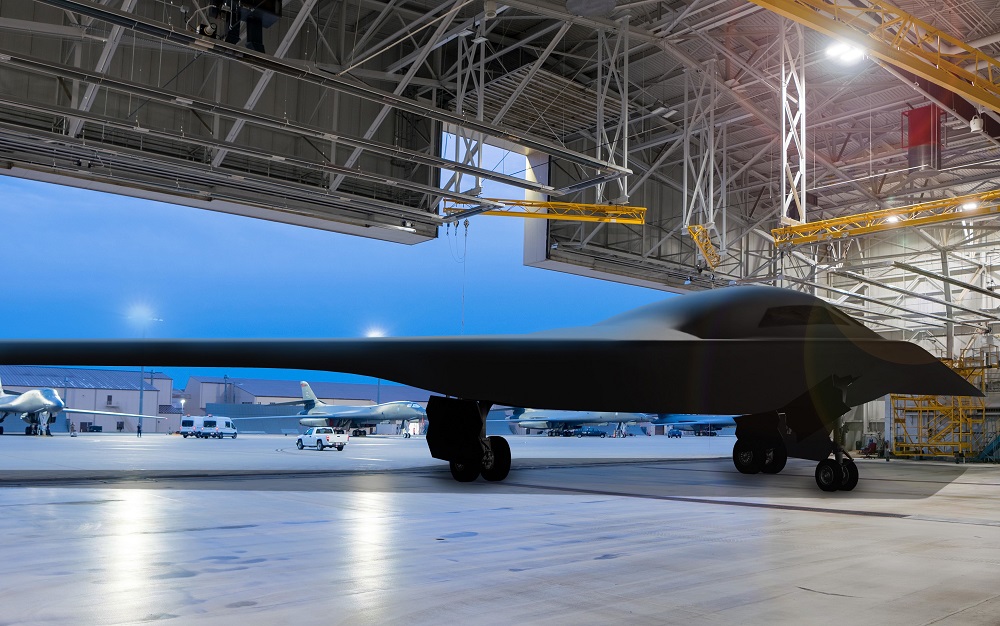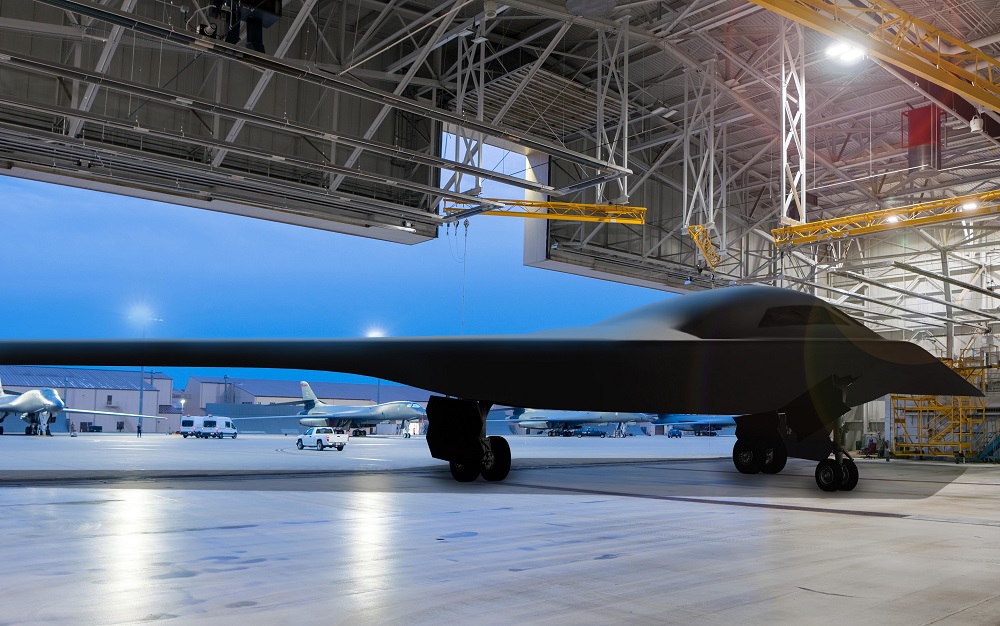
A senior Washington official has indicated that the United States would consider providing Australia with B-21 Raider long-range bombers, if Canberra requested them.
US Air Force Secretary Frank Kendall was hosted in Canberra this week by the new chief of the Royal Australian Air Force, Air Marshal Robert Chipman. The two fielded questions at a media briefing.
It has long been accepted that the US wouldn’t provide allies such as Australia with platforms such as nuclear-powered submarines and certain aircraft such as the formidable and stealthy F-22 fighter. At least in the case of submarines, the rapidly deteriorating global strategic situation brought a dramatic change in that thinking with the AUKUS agreement a year ago. The AUKUS partnership opened the way for the UK and US to help Australia obtain the submarines and to collaborate on a range of other defence capabilities.
Asked by The Strategist if the US would consider allowing Australia to join its development of the B-21 to provide the RAAF with a long-range strike capability, Kendall said that, generally speaking, Australia acquired the weapon systems it needed for its defence. ‘And I think the United States, in general, would be willing to talk to Australia about anything that there was an interest in from the Australian perspective that we could help them with.’
Close cooperation on the F-35 joint strike fighter was an example, Kendall said. ‘So, I don’t think that there’s any fundamental limitation on the areas in which we can cooperate. If Australia had a requirement for long-range strike, and I think I’d turn it over to the chief of air staff to talk about that, then we’d be willing to have a conversation with them about that.’
Chipman then said more would be learned as the government’s defence strategic review progressed on the role of long-range strike in Australia’s force structure. ‘But what I would say is, if we were to invest in long-range strike, then it’s got to be balanced. We’d also need to be able to protect and sustain those platforms while they’re on the ground in Australia. So, while we might work with the US on B-21, that’s a small part of an overall strike capability that we would need in Australia.’
Kendall is responsible for organising, training and equipping US air and space forces. He said his visit to Australia and time spent with the RAAF chief was part of US liaison with its closest partners. ‘I liaise around the world under a rubric of integrated deterrence, that we are all stronger by operating closely together and supporting each other’s capabilities,’ Kendall said. ‘A free and open Pacific is incredibly important to us.’
A key focus of his trip was on modernisation, and he was discussing options with his Australian counterparts on how to collaboratively develop the air and space capabilities both countries needed. The American decision to acquire the E-7A Wedgetail command-and-control aircraft was an example of what the US could learn from Australia, Kendall said.
US fliers and their commanders have been deeply impressed by the Wedgetail’s performance on operations. Based on Boeing’s 737 airliner and developed for the RAAF, the aircraft proved highly successful on missions over Iraq and Syria during the war on the Islamic State terror group and was clearly superior to US equivalents such as ageing E-3 Sentry airborne warning and control system aircraft, or AWACS.
‘This demonstrates that there’s very much a two-way street,’ Kendall said, ‘that we depend upon our partners just as much as they depend upon us in any number of ways.’
On this trip he was also visiting Japan and US forces in Hawaii, Guam and Alaska. ‘All of this represents an integrated strategic capability that the US and its partners around the world use to keep peace and stability in the region.’
Kendall also said he was talking to Australians about possible cooperation on unmanned aircraft, including Boeing Australia’s MQ-28 Ghost Bat. ‘There are a lot of options on the table right now. We’re having preliminary discussions. I think there’s a lot of mutual interest in working together and we’re going to be sorting out the details over the next few weeks and months.’
Chipman said the RAAF was excited by the MQ-28 program in Australia. ‘It’s a great innovation. It’s something that has been homegrown for the first time in a long time in Australia. But my interest is in accelerating the program, and that’s where working closely with our allies is so useful, because we can operationalise it and bring it into service more quickly.’
The cost of an unmanned aircraft was dramatically lower than a manned fighter and it could be procured in large numbers, he said. The US had until now bought better and better versions of the things that it already had. ‘And I think we need to rethink that, and the uncrewed combat aircraft is one opportunity to do that.’
And was there room for cooperation with Australia?
‘Absolutely,’ said Kendall, ‘That’s why I’m here.’
Asked about RAAF operations over areas in the South China Sea militarised by China, Kendall responded that the US and its allies were all concerned about Chinese behaviour in the region. ‘I think my Australian counterparts are very interested and focused on this too. And keeping high awareness of what kind of activities are going on in that part of the world is important to all of us.’
Chipman said the RAAF operated in the South China Sea to maintain the status quo, to preserve the rules-based global order and to exercise freedom of navigation under international law. ‘We have, and they’re well-publicised, experienced recent encounters with the Chinese, which have been robust to say the least. And to make a finer point, they’ve been unsafe. We see the Chinese as an incredibly capable, modern military. What should follow are high standards of professionalism, and we would like to see the same standards of professionalism from the Chinese that we extend to them.’
The RAAF chief said safety issues were being monitored very closely. ‘We certainly have seen a recent spate of unsafe incidents, but it’s not a trend line that we can see sustained.’
Chipman said RAAF operations hadn’t changed. ‘It is still business as usual for us. We force generate our crews to a very high standard. They’re capable of operating in contested environments. And so we think they’re well equipped to continue operating in the South China Sea.’
He added later that the RAAF was designed to be able to respond very quickly to a range of scenarios in the region.
On the question of whether Chinese platforms such as the stealthy J-20 fighter were getting close to the capability of the US-designed F-35, Kendall said he’d been very concerned about China’s military modernisation program for some time. ‘I had spent most of my life in the intersection of technology and operational capabilities and came back into government in 2010 and looked at what China was doing to develop and modernise their military. And it was quite clear that they were developing the capability to try to keep others away from their shores, including the United States and its partners, and that they were pretty well down the path towards fielding those kinds of capabilities,’ Kendall said. The label given then was anti-access, area denial, or A2/AD.
‘I come back again, a dozen years later, and they’ve continued on that path very aggressively. And it’s of concern, I think, to everyone in the region. It has big implications for peace and stability in the region.’
China’s defence investments were widespread, strategic and focused, he said. ‘They’re acquiring technology through intellectual property theft and through generating it themselves. They’re educating their engineering workforce, largely overseas in universities and other places. They are as formidable a strategic opponent as I have seen. And I spent 20 years as a court lawyer. So, they are investing very thoughtfully and with significant resources with a great breadth of capabilities that they’re trying to field or have fielded. And they continue to do that.’
China was thinking ahead on how the US and its allies might respond so that they could develop countermeasures, Kendall said. ‘We are in what I consider to be a race for military technological superiority with the Chinese. There are a number of areas in which I feel very confident about America’s capabilities.’
It was difficult to know if there’d be parity between the US and China, Kendall said. ‘A number of things are not obvious, such as electronic warfare capabilities, war reserve modes for radars, counter-countermeasures, deception techniques, and so on. Some things we’re not very concerned about; other things we’re more concerned about. But there’s going to be a lot that we don’t know about each other’s capabilities.’
The war in Ukraine had demonstrated that some Russian capabilities that looked good on paper turned out to be much less effective when they were used, Kendall said.
‘I would hope that Xi Jinping learns three lessons from what he’s seeing happening right now. The economic consequences of an aggressive action may be much more severe than you’d anticipated. And that should be a significant deterrent. The capabilities your military is telling you it has may not be an accurate description of what they have. And the short war you anticipate may not be the war you get. So I’m hopeful that those will be the lessons he learns from what he’s seeing right now.’
Chipman added that that underscored the importance of AUKUS, ‘where we work together to collaboratively develop and research and engineer new technologies so that we can stay abreast and competitive’.

Senior US official says Washington would consider supplying B-21 bombers to Australia | The Strategist
A senior Washington official has indicated that the United States would consider providing Australia with B-21 Raider long-range bombers, if Canberra requested them. US Air Force Secretary Frank Kendall was hosted in Canberra this week ...






